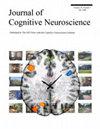大脑皮层模式相似性的后续记忆效应因语义类别而异
IF 3.1
3区 医学
Q2 NEUROSCIENCES
引用次数: 0
摘要
众所周知,生物刺激和非生物刺激在感知过程中会依赖于不同的大脑区域,但它们的外显记忆编码机制是否也存在差异,这在很大程度上还是个未知数。为了研究这个问题,我们要求参与者对物体图片(如老虎的图片)进行编码,并在之后根据其名称(如单词 "老虎")对其进行检索。对于四种语义类别(活体-有生命的、活体-无生命的、非活体-大的和非活体-小的)中的每一种,我们都检查了随后记忆的项目与遗忘的项目在激活模式相似性(神经模式相似性 [NPS])上的差异。记忆项目的 NPS 越高,表明类内项目的相似性越好,而记忆项目的 NPS 越低,表明项目的独特性越好。我们预计,记忆项目在特定类别区域内的 NPS 会高于遗忘项目。例如,海马旁皮层在场景处理中的作用众所周知[Aminoff, E. M., Kveraga, K., & Bar, M. The role of the parahippocampal cortex in cognition.Clarke, A., & Tyler, L. K. Object-specific semantic coding in human perirhinal cortex.Journal of Neuroscience, 34, 4766-4775, 2014]。因此,我们预计在这些分别与场景和物体有关的区域中,记忆项目的 NPS 会更高。与这一假设一致的是,在纺锤体、海马旁和回脾区域,较高的NPS预示着对非生物物体子类的记忆,而在左下额叶和左回脾区域,较低的NPS预示着对生物物体子类的记忆。总之,这些结果支持了后续记忆取决于相似性和独特性之间平衡的观点,并证明了不同语义类别的外显编码神经机制是不同的。本文章由计算机程序翻译,如有差异,请以英文原文为准。
Subsequent Memory Effects in Cortical Pattern Similarity Differ by Semantic Class
Although living and nonliving stimuli are known to rely on distinct brain regions during perception, it is largely unknown if their episodic memory encoding mechanisms differ as well. To investigate this issue, we asked participants to encode object pictures (e.g., a picture of a tiger) and to retrieve them later in response to their names (e.g., word “tiger”). For each of four semantic classes (living-animate, living-inanimate, nonliving-large, and nonliving-small), we examined differences in the similarity in activation patterns (neural pattern similarity [NPS]) for subsequently remembered versus forgotten items. Higher NPS for remembered items suggests an advantage of within-class item similarity, whereas lower NPS for remembered items indicates an advantage for item distinctiveness. We expect NPS within class-specific regions to be higher for remembered than for forgotten items. For example, the parahippocampal cortex has a well-known role in scene processing [Aminoff, E. M., Kveraga, K., & Bar, M. The role of the parahippocampal cortex in cognition. Trends in Cognitive Sciences, 17, 379–390, 2013], and the anterior temporal and inferior frontal gyrus have well-known roles in object processing [Clarke, A., & Tyler, L. K. Object-specific semantic coding in human perirhinal cortex. Journal of Neuroscience, 34, 4766–4775, 2014]. As such, we expect to see higher NPS for remembered items in these regions pertaining to scenes and objects, respectively. Consistent with this hypothesis, in fusiform, parahippocampal, and retrosplenial regions, higher NPS predicted memory for subclasses of nonliving objects, whereas in the left inferior frontal and left retrosplenial regions, lower NPS predicted memory for subclasses of living objects. Taken together, the results support the idea that subsequent memory depends on a balance of similarity and distinctiveness and demonstrate that the neural mechanisms of episodic encoding differ across semantic categories.
求助全文
通过发布文献求助,成功后即可免费获取论文全文。
去求助
来源期刊
CiteScore
5.30
自引率
3.10%
发文量
151
审稿时长
3-8 weeks
期刊介绍:
Journal of Cognitive Neuroscience investigates brain–behavior interaction and promotes lively interchange among the mind sciences.

 求助内容:
求助内容: 应助结果提醒方式:
应助结果提醒方式:


